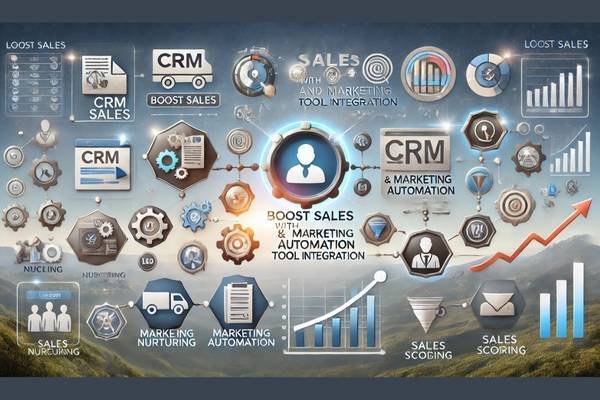
Top 10 Marketing Automation Tools to Streamline Your Campaigns in 2025
September 30, 2024
How to Boost eCommerce Sales with Marketing Automation Tools
September 30, 2024How to Boost Sales with CRM and Marketing Automation Tool Integration
In today’s competitive digital landscape, the integration of CRM (Customer Relationship Management) systems and marketing automation tools has become crucial for businesses aiming to scale their sales. This strategy helps streamline workflows, enhance customer engagement, and, most importantly, increase revenue. In this article, we will dive deep into how these tools, when effectively integrated, can revolutionize your sales process.
Table of Contents
1. Understanding CRM and Marketing Automation Tools
What Is a CRM System?
A CRM system allows businesses to manage relationships with both existing and potential customers. It centralizes customer data, enabling sales teams to track interactions, manage leads, and optimize communication. Popular CRM tools include Salesforce, HubSpot CRM, and Zoho CRM.
What Is Marketing Automation?
Marketing automation tools help marketers automate repetitive tasks, such as sending email campaigns, segmenting audiences, and tracking customer behaviors. These tools, such as Mailchimp, ActiveCampaign, and Marketo, save time and ensure more precise targeting.
Why Integrate CRM with Marketing Automation Tools?
Integrating CRM and marketing automation tools bridges the gap between marketing and sales teams. It ensures that all customer touchpoints are tracked, giving sales representatives a 360-degree view of each customer. This integration leads to:
- Better lead management: Leads can be nurtured more effectively by targeting them with personalized content.
- Increased efficiency: Marketing automation tools reduce manual efforts, freeing up time for both sales and marketing teams.
- Enhanced data accuracy: Information is synchronized between systems, reducing the risk of errors and outdated data.
2. How CRM and Marketing Automation Integration Boosts Sales
2.1. Automating Lead Nurturing
Integrating your CRM with a marketing automation tool allows for automatic lead nurturing. Instead of manually following up with leads, you can set up workflows that send personalized messages based on user behavior. This ensures leads receive relevant content at the right time.
- Example: If a potential customer visits your pricing page but does not make a purchase, your marketing automation system can trigger an email with more information or a special discount. The CRM tracks this activity, allowing the sales team to follow up if needed.
2.2. Aligning Marketing and Sales Teams
One of the biggest challenges businesses face is the disconnect between their marketing and sales departments. By integrating CRM and marketing automation, both teams can access the same data, resulting in a seamless transition from lead generation to closing a deal.
- Benefit: Marketing automation tools provide valuable data, such as which campaigns a prospect has interacted with, while the CRM shows where they are in the sales funnel. This alignment ensures leads are properly nurtured and followed up on without any confusion or duplication of efforts.
2.3. Personalization at Scale
Customers expect personalized experiences, and integrating CRM with marketing automation helps businesses meet this expectation. Data from the CRM can be used to create highly segmented email campaigns, tailored to each customer’s unique interests and buying stage.
- Statistical Insight: According to Salesforce, 79% of customers are more likely to engage with a brand offering personalized experiences. With CRM and automation, this becomes much easier to achieve.
2.4. Improving Lead Scoring
Lead scoring is essential to prioritize leads based on their likelihood to convert. Integrating marketing automation with CRM enhances lead scoring by using behavioral data from marketing activities.
- How it Works: If a lead opens multiple emails, downloads content, or visits key pages on your website, they earn points. When the lead reaches a certain score, the CRM notifies the sales team to take action. This prevents sales from wasting time on unqualified leads and focuses their efforts on high-value opportunities.
2.5. Automating Re-Engagement Campaigns
Every business experiences leads that go cold. Re-engaging these leads is critical, and automation can handle it seamlessly. With a CRM, you can track when a lead was last contacted and set up automated re-engagement workflows.
- Example: An email can automatically be sent to a lead who hasn’t interacted with your content in over 30 days, prompting them to come back with a special offer or helpful resource.
3. Steps to Integrate CRM and Marketing Automation
3.1. Choosing the Right Tools
First, select CRM and marketing automation tools that are compatible. Some of the best integrations include:
- Salesforce and Pardot: Pardot is Salesforce’s native marketing automation tool, making it an ideal pairing for seamless integration.
- HubSpot: HubSpot’s all-in-one platform includes both CRM and marketing automation, providing a unified system.
- Zoho CRM and ActiveCampaign: ActiveCampaign is known for its robust automation features and integrates smoothly with Zoho CRM.
3.2. Define Your Workflow
Before you begin the integration, outline your workflow. How will leads move through the funnel? What triggers should initiate actions? Ensure that both your marketing and sales teams agree on the process.
3.3. Automating Data Sync
Make sure all customer data is synchronized between your CRM and marketing automation tool. This ensures that no lead information is lost, and your teams have real-time access to critical data.
3.4. Setting Up Triggers and Workflows
Set up automated workflows based on customer actions. For example, if a lead fills out a form on your website, the automation tool can notify the CRM, assign the lead to a sales representative, and send a personalized email.
4. Best Practices for CRM and Marketing Automation Integration
4.1. Regular Data Audits
Ensure your CRM data remains accurate by conducting regular data audits. This will prevent your marketing automation campaigns from targeting the wrong contacts or sending irrelevant information.
4.2. Test and Optimize
After integrating your CRM and marketing automation, monitor performance closely. Test different workflows, email campaigns, and lead scoring models to find what works best.
4.3. Train Your Teams
Training is crucial to successful integration. Both your marketing and sales teams should know how to use the integrated system to its full potential. Ensure they understand the workflows, triggers, and the value of using these tools together.
4.4. Leverage Reporting Features
Both CRM and marketing automation tools provide detailed reports on lead engagement, conversion rates, and sales performance. Use this data to make informed decisions and improve your strategy.
5. Key Metrics to Track for Success
5.1. Conversion Rates
Monitor how many leads turn into paying customers after implementing the integration. A well-integrated system should boost conversion rates by providing more qualified leads to the sales team.
5.2. Lead Response Time
The quicker you respond to a lead, the higher your chances of converting them. With automation, you can significantly reduce response time and ensure timely follow-ups.
5.3. Customer Lifetime Value (CLV)
A CRM and marketing automation integration allows for personalized customer journeys, ultimately increasing CLV by nurturing relationships long after the initial sale.
How to Boost Sales with CRM and Marketing Automation Tool Integration, Recap
Frequently Asked Questions
1. Why should I integrate my CRM with marketing automation tools?
Integrating CRM with marketing automation tools allows for streamlined lead management, enhanced personalization, and better communication between sales and marketing teams. It boosts sales by delivering timely, relevant content to the right audience, ultimately increasing conversion rates.
2. What are the challenges of integrating CRM and marketing automation tools?
Some challenges include selecting compatible systems, ensuring data accuracy, and properly aligning sales and marketing workflows. Training teams on the new integrated system and performing regular data audits can help mitigate these challenges.
3. Can small businesses benefit from CRM and marketing automation integration?
Yes, small businesses can greatly benefit from integrating CRM and marketing automation tools. The automation of repetitive tasks and improved lead management helps small teams work more efficiently, enabling them to compete with larger enterprises.
Conclusion
Integrating CRM and marketing automation tools is no longer just an option for businesses looking to grow—it’s a necessity. This powerful combination enables businesses to improve lead nurturing, align sales and marketing teams, and increase efficiency, all of which lead to boosted sales and enhanced customer satisfaction.
To get started, choose the right tools for your business, outline your workflows, and ensure that your teams are properly trained. Once implemented, track key metrics and continuously optimize your process to see the full benefits of this powerful integration.
Incorporating CRM and marketing automation is an investment in your business’s future, helping you stay competitive in a fast-paced digital world.








